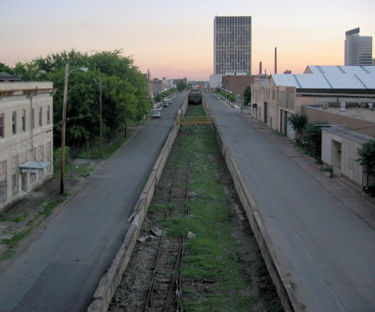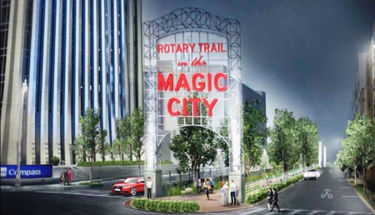Rotary Trail: Difference between revisions
No edit summary |
No edit summary |
||
| Line 5: | Line 5: | ||
The idea of using the railroad cut for recreation dates back to at least the 1980s. Former [[Birmingham City Council]] member [[Elias Hendricks]] headed an informal "Save the Cut" movement in response to proposals in the [[2003 City Center Master Plan]] to fill in the below-grade areas and plant trees in the resulting street-level median to create a boulevard on 1st Avenue South. The [[Central City neighborhood association]] has organized periodic clean-up days to keep the cut cleared of debris. | The idea of using the railroad cut for recreation dates back to at least the 1980s. Former [[Birmingham City Council]] member [[Elias Hendricks]] headed an informal "Save the Cut" movement in response to proposals in the [[2003 City Center Master Plan]] to fill in the below-grade areas and plant trees in the resulting street-level median to create a boulevard on 1st Avenue South. The [[Central City neighborhood association]] has organized periodic clean-up days to keep the cut cleared of debris. | ||
The Rotary Club | The Rotary Club jump started the project with a $2.5 million commitment and sought to partner with the city, the [[Freshwater Land Trust]], [[Operation New Birmingham]] and the [[Railroad Park Foundation]] to reclaim the cut as part of a pedestrian and cycling greenway. At the same time, students from [[Auburn University]]'s Master of Landscape Architecture program participated in an [http://aurbanmla.blogspot.com/ Urban Design Studio] focusing on how to re-work the cut as a pedestrian corridor. The club hired [[Jane Ross]] of [[Goodwyn, Mills and Cawood]] to prepare design drawings for a linear park with running paths, benches, landscaping, lighting and other amenities. The western entrance will be marked by a 46-foot-tall homage to the [[Magic City sign]] that formerly graced [[5th Avenue North]] outside the [[Birmingham Terminal Station]]. Stairways will be built to connect the park to street grade below [[Rainbow Viaduct]] spanning it at [[21st Street South|Richard Arrington, Jr Boulevard South]]. An amphitheater will be constructed at [[23rd Street South|23rd Street]] with another entrance way marking the [[24th Street South|24th Street]] end of the trail. | ||
In addition to the major gift from the Rotary Club, the City of [[Birmingham]] has promised $2 million in streetscape and infrastructure improvements to enhance the project. The trail is envisioned to expand the [[Railroad Park]]'s impact eastward into [[downtown Birmingham]] and to serve as part of a proposed "Cross to Sloss" continuous recreational link between the [[Birmingham CrossPlex]] at [[Fair Park]] and [[Sloss Furnaces]]. That corridor would also incorporate the [[Jones Valley Trail]], which is part of the overall [[Red Rock Ridge and Valley Trail System]]. | In addition to the major gift from the Rotary Club, the City of [[Birmingham]] has promised $2 million in streetscape and infrastructure improvements to enhance the project. The trail is envisioned to expand the [[Railroad Park]]'s impact eastward into [[downtown Birmingham]] and to serve as part of a proposed "Cross to Sloss" continuous recreational link between the [[Birmingham CrossPlex]] at [[Fair Park]] and [[Sloss Furnaces]]. That corridor would also incorporate the [[Jones Valley Trail]], which is part of the overall [[Red Rock Ridge and Valley Trail System]]. | ||
| Line 13: | Line 13: | ||
* Spencer, Thomas (July 4, 2012) "Rotary Club of Birmingham exploring greenway linking Railroad Park and Sloss Furnaces." {{BN}} | * Spencer, Thomas (July 4, 2012) "Rotary Club of Birmingham exploring greenway linking Railroad Park and Sloss Furnaces." {{BN}} | ||
* Tomberlin, Michael (December 29, 2013) "First look: $4.5 million Rotary Trail will extend Railroad Park greenway past 24th Street." {{BN}} | * Tomberlin, Michael (December 29, 2013) "First look: $4.5 million Rotary Trail will extend Railroad Park greenway past 24th Street." {{BN}} | ||
* Tomberlin, Michael (March 10, 2014) "Rotary Trail could get $3.5 million backing from Birmingham for linear park." {{BN}} | |||
[[Category:1st Avenue South]] | [[Category:1st Avenue South]] | ||
Revision as of 14:04, 10 March 2014

Rotary Trail (formerly called Line Park) is a pedestrian greenway constructed in 2014 in the railroad cut in the center of 1st Avenue South between 20th and 24th Street South. The project was proposed and largely funded by the Rotary Club of Birmingham in recognition of their centennial year.
The idea of using the railroad cut for recreation dates back to at least the 1980s. Former Birmingham City Council member Elias Hendricks headed an informal "Save the Cut" movement in response to proposals in the 2003 City Center Master Plan to fill in the below-grade areas and plant trees in the resulting street-level median to create a boulevard on 1st Avenue South. The Central City neighborhood association has organized periodic clean-up days to keep the cut cleared of debris.
The Rotary Club jump started the project with a $2.5 million commitment and sought to partner with the city, the Freshwater Land Trust, Operation New Birmingham and the Railroad Park Foundation to reclaim the cut as part of a pedestrian and cycling greenway. At the same time, students from Auburn University's Master of Landscape Architecture program participated in an Urban Design Studio focusing on how to re-work the cut as a pedestrian corridor. The club hired Jane Ross of Goodwyn, Mills and Cawood to prepare design drawings for a linear park with running paths, benches, landscaping, lighting and other amenities. The western entrance will be marked by a 46-foot-tall homage to the Magic City sign that formerly graced 5th Avenue North outside the Birmingham Terminal Station. Stairways will be built to connect the park to street grade below Rainbow Viaduct spanning it at Richard Arrington, Jr Boulevard South. An amphitheater will be constructed at 23rd Street with another entrance way marking the 24th Street end of the trail.
In addition to the major gift from the Rotary Club, the City of Birmingham has promised $2 million in streetscape and infrastructure improvements to enhance the project. The trail is envisioned to expand the Railroad Park's impact eastward into downtown Birmingham and to serve as part of a proposed "Cross to Sloss" continuous recreational link between the Birmingham CrossPlex at Fair Park and Sloss Furnaces. That corridor would also incorporate the Jones Valley Trail, which is part of the overall Red Rock Ridge and Valley Trail System.
References
- Coman, Victoria L. (April 27, 2005) "Central City looks for help to tidy up old railroad cut." The Birmingham News
- Spencer, Thomas (July 4, 2012) "Rotary Club of Birmingham exploring greenway linking Railroad Park and Sloss Furnaces." The Birmingham News
- Tomberlin, Michael (December 29, 2013) "First look: $4.5 million Rotary Trail will extend Railroad Park greenway past 24th Street." The Birmingham News
- Tomberlin, Michael (March 10, 2014) "Rotary Trail could get $3.5 million backing from Birmingham for linear park." The Birmingham News
